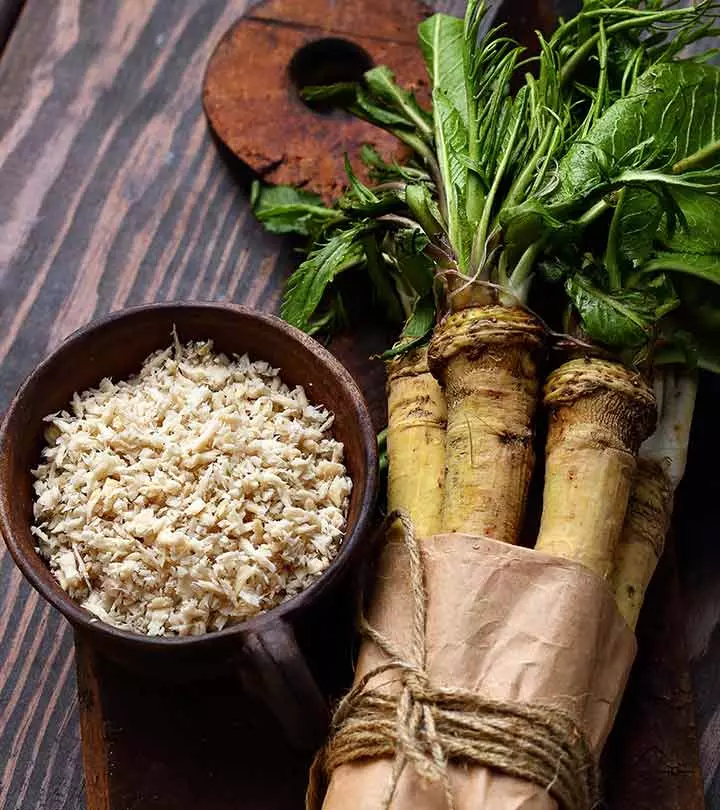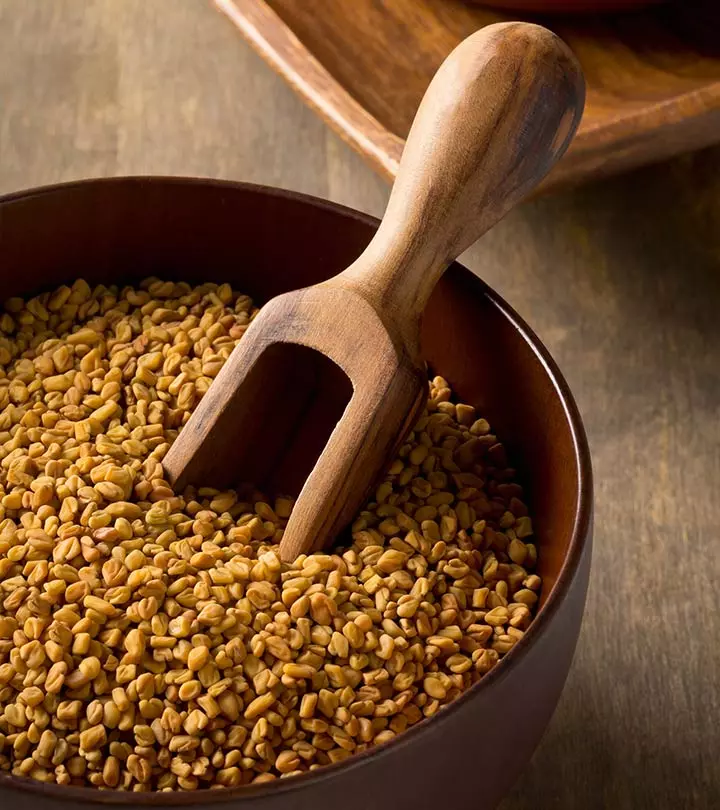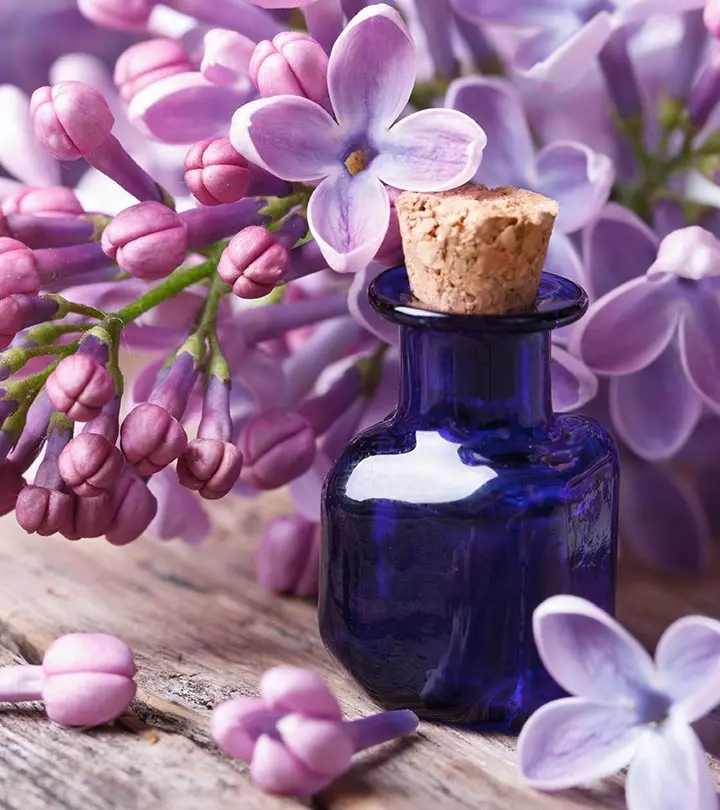Benefits Of Horseradish: Nutritional Profile & Recipes
Utilize this condiment to combat UTIs, digestive issues, inflammation, and more.

Image: Shutterstock
The many benefits of horseradish can entice you to add it to your diet. Horseradish is a popular condiment with a strong flavor. It originated in South-East Europe and has many health benefits. It contains bioactive compounds that may have anti-cancer properties. It is also loaded with antioxidants and may relieve respiratory disorders such as sinusitis. This article discusses the benefits of horseradish, its nutritional profile, and its risks. Scroll down.
 Know Your Ingredient: Horseradish
Know Your Ingredient: HorseradishWhat Is It?
A root vegetable used as a spice and condiment and known for its pungent taste and smell.
What Are Its Benefits?
It helps improve digestion, fights inflammation, reduces age spots, promotes hair growth, and helps fight cancer.
Who Can Use It?
All except people with hyperthyroidism, digestive issues, and kidney problems.
How Often?
Regularly.
Caution
Individuals with stomach ulcers and digestive issues or those who are pregnant and breastfeeding should avoid consuming it in large quantities.
In This Article
What Is Horseradish?
It is a spicy root vegetable known for its pungent taste and odor. This vegetable is believed to be native to Eastern Europe. It is often confused with Wasabi, a popular pungent condiment used in Japanese cuisine. Scroll down to the next section to know more about how is horseradish good for you.
Key Takeaways
- Horseradish root is rich in antioxidants and exhibits several medicinal properties that help treat respiratory and digestive ailments.
- The bioactive compounds in this root help combat cancer and treat UTI infections.
- In addition, it may help fight inflammation, treat melasma, and boost hair growth.
- However, it may cause hypothyroidism, worsen kidney issues, and cause digestive problems in some people.
How Is Horseradish Good For You?
Some of the important benefits of horseradish come from its component allyl isothiocyanate, which is known to prevent different forms of cancer.
Other compounds in horseradish, namely glucosinolate and sinigrin, also possess chemopreventivei The property of any specific medication or food substance that helps reduce a person's risk of cancer. effects. The root contains several other antioxidants that treat respiratory disorders like mucus and sinus infection. Owing to their antibacterial properties, they help to combat bacterial infections, including that of the urinary tract.
 Did You Know?
Did You Know?And like we said, there are several other ways horseradish can do wonders for your health.
What Are The Benefits Of Horseradish?
1. Horseradish Helps Combat Cancer

The glucosinolates in horseradish were found to activate the cancer-fighting enzymes, and this can prove beneficial to patients combating cancer (1). What is more interesting is that these glucosinolates, in the plant world, actually protect the plants from toxic environments. In fact, horseradish contains 10 times more glucosinolates than broccoli.
There are other preliminary studies that state how horseradish can induce cell death in the case of colon cancer (2). All of this only accentuates the possibility of glucosinolates being used as a potential cancer cure (3).
2. Is An Antioxidant Powerhouse
Horseradish root possesses several phytocompounds, types of antioxidants that are extremely beneficial to human health
(4). Some other antioxidants in horseradish are antimutagenici A property of a substance that prevents a chemical from being mutagenic (altering a cell's DNA). , which means that they can protect the body from mutagens that otherwise inflict grave harm.
Horseradish contains high levels of rutin, which is a flavonoid that may be responsible for its high antioxidant performance. A study that analyzed the phenolic content and bioactivity of horseradish leaf and root extracts showed high concentrations of rutin and rutin retention after the experiment.

Mean Estimation Of Rutin Content In Horseradish Leaf And Root Extract
Source: Microencapsulation of Horseradish (Armoracia rusticana L.) Juice Using Spray-DryingThere is research that also shows how horseradish has ayurvedic properties and can help in decreasing the DNA damage caused by oxidative stress (5).
3. Can Help Treat Urinary Tract Infections

The antibiotic properties of horseradish can help treat urinary tract infections in some cases, better than conventional treatment (6). Another reason horseradish works well in this aspect is sinigrin, the compound we spoke of initially. Sinigrin is an effective diuretic and prevents water retention, and this helps deal with urinary tract infections.
Did You Know?
Horseradish is still planted and harvested by hand.
4. Enhances Digestion
Certain enzymes in the root can stimulate digestion and aid bowel movements. Horseradish root is a low calorie food and is also considered a cholagogue, i.e., it stimulates bile production in the gallbladder – thereby aiding digestion (7).
And the little fiber in the root can also improve digestion.
However, certain reports also recommend horseradish against digestive issues. Hence, it is best to consult your doctor.
5. Fights Inflammation

One Italian study states that horseradish can help fight inflammation – it achieves this by reducing the release of reactive oxygen species (8). Several parts of Chinese medicine have recommended the use of horseradish to help prevent inflammation – be it in the case of injury or even for relief from arthritis pains.
However, we need more research on this.
6. Eases Respiratory Ailments

The antibiotic properties of the root can play a major role in treating respiratory ailments. In fact, traditional medicine has seen the use of horseradish root for treating bronchitis, cough, common cold, and sinusitisi A disorder that inflames the cavities around the nasal passages due to seasonal cold or allergies. .
A study was conducted on 384 patients to test the effect of horseradish and nasturtium on acute bronchitis. The participants were split into two groups where group 1 was given the formulation and group 2 was given a placebo. It was seen that the health improvement rate on the 3rd, 7th, and 10th days were 60%, 94%, and 96% in comparison to the healing rates of 40%, 86%, and 94% in group 2.
The results of a study were quite surprising. When a drug containing horseradish root was tested against conventional antibiotics, the results were quite comparable. The root was able to help treat sinusitis (or congestion) and bronchitis in ways similar to that of the treatment (9).
7. Has Antimicrobial Properties
It is the allyl isothiocyanate in the root that offers antimicrobial properties. Studies have shown that this compound can offer protection against a variety of microbes (10). And in yet another study, roast beef added with horseradish essential oil displayed the most resistance against bacterial growth (11).
The antimicrobial properties of horseradish also help in the treatment of ear infections.
8. Helps Treat Melasma
Melasma is a condition where brown patches appear on the face. But since horseradish root has bleaching properties, it can help treat skin discoloration – which is the primary symptom of melasma.
You can simply cut the horseradish root into slices and rub one directly on your skin. Ensure the juice of the root is applied to the affected areas. You can allow it to dry and then rinse with lukewarm water and pat dry. Repeat once a week until the brown patches fade.
You can also mix two tablespoons of horseradish powder with one cup of sour cream. Apply the mixture to your face and leave it on for 30 minutes. Wash your face with lukewarm water. Repeat once a week until you see positive results.
Did You Know?
A study conducted by MIT showed that an enzyme in horseradish, called horseradish peroxidase, can clean wastewater by removing a number of pollutants.
9. Horseradish Can Help Reduce Age Spots

The skin-lightening properties of horseradish have a role to play here.
You can make horseradish paste and apply it to the affected areas. Leave it on for about 20 minutes and then wash it off with lukewarm water. You can follow this remedy a few times a week.
Alternately, you can grate a four-inch piece of horseradish and mix it with a quarter cup of apple cider vinegar. Allow the mixture to sit for about two weeks, post which you strain it. Using a cotton ball, apply it to the affected areas. Follow this remedy thrice a day for about a month.
 Quick Tip
Quick Tip10. Can Boost Hair Growth
Though there is little research on this, some sources say that the antioxidants in horseradish help regenerate hair and prevent hair loss. They achieve this by improving circulation to the scalp.
Simply prepare a poultice from horseradish and apply to your scalp. Leave it on for about 20 minutes and then shampoo as usual.
These are the benefits of the much popular condiment, which is now gaining acclaim for its goodness as well. But how do you measure goodness? Yes, with the nutrients.
What Is The Nutritional Profile Of Horseradish?
| SEE THE TABLE BELOW FOR IN DEPTH ANALYSIS OF NUTRIENTS: NUTRITION VALUE PER 100 G | ||
|---|---|---|
| Principle | Nutrient Value | Percentage of RDA |
| Energy | 48 cal | 2% |
| Carbohydrates | 11.29 g | 9% |
| Protein | 1.18 g | 2% |
| Total Fat | 0.69 g | 3% |
| Cholesterol | 0mg | 0% |
| Dietary Fiber | 3.3 g | 9% |
| VITAMINS | ||
| Folates | 57 µg | 14% |
| Niacin | 0.386 mg | 2.5% |
| Pantothenic acid | 0.093 mg | 2% |
| Pyridoxine | 0.073 mg | 6% |
| Riboflavin | 0.024 mg | 2% |
| Thiamin | 0.008 mg | 1% |
| Vitamin A | 2 IU | 1% |
| Vitamin C | 24.9 mg | 41% |
| ELECTROLYTES | ||
| Sodium | 314 mg | 21% |
| Potassium | 246 mg | 5% |
| MINERALS | ||
| Calcium | 56 mg | 6% |
| Copper | 0.058 mg | 6% |
| Iron | 0.42 mg | 5% |
| Magnesium | 27 mg | 7% |
| Manganese | 0.126 mg | 5.5% |
| Phosphorus | 31 mg | 4.5% |
| Zinc | 0.83 mg | 8% |
| PHYTO-NUTRIENTS | ||
| Carotene-ß | 1 µg | – |
| Crypto-xanthin-ß | 0 µg | – |
| Lutein-zeaxanthin | 10 µg | – |
Knowing horseradish’s nutritional profile can help you incorporate it into your meals in a balanced way. Further, there are a variety of delicious culinary methods that enable you to avail their health benefits. Scroll down to know more.
How To Incorporate Horseradish Into Your Diet
Adding horseradish to your food can improve flavor and give it a spicy kick. Here are some easy ways to add horseradish to your diet:
- Add horseradish to salad dressings for a zesty edge that goes well with vegetables and leafy greens.
- Improve the flavor profile of roasted vegetables, especially root vegetables like potatoes and carrots by pairing them with horseradish.
- Apply it to steaks or fish before grilling, or incorporate it into marinades, to use as a meat spice.
- Stir it into condiments such as sour cream or cocktail sauce for an additional layer of heat.
- Spread it on burgers or sandwiches to give the rich ingredients a peppery twist.
Learn an easy horseradish recipe below.
Easy Horseradish Recipe To Try
Horseradish Mashed Potatoes
Ingredients
- ½ cup of warm milk
- 3 pounds of Yukon gold potatoes
- 8 ounces of cream cheese
- 1/3 cup of salted butter
- ¼ cup of prepared horseradish
- 4 garlic cloves
- 1 green onion, thinly sliced
- 1 tablespoon of fresh parsley
- Salt and pepper to taste
How To Prepare
1. Place the garlic cloves and potatoes in a large pot filled with cold salted water.
2. Bring the water to a boil, reduce heat to simmer, and cook the potatoes for 15–20 minutes.
3. Drain the potatoes and garlic, then place them back in the warm pot.
4. Add the cream cheese and butter to the potatoes, then mash the ingredients with a masher.
5. Pour in the warmed milk while continuing to mash the ingredients until they are smooth and creamy.
6. Stir in the horseradish, green onion, and parsley for flavor.
7. Season the mashed potatoes with salt and pepper and serve hot.
This brings us to one important question. What’s the difference between horseradish and wasabi, it’s Japanese cousin?
Horseradish Vs. Wasabi – What’s The Difference?
The similarity is that both of them belong to the same family of plants (called Brassica) that also includes broccoli, cabbage, Brussels sprouts, and mustard. And both of them are known for their wickedly pungent flavors.
Talking about the differences, horseradish is cultivated primarily for its large roots (which are brown-skinned and pure white inside). And wasabi is grown for its bright green stem.
And though the two have an evil flavor that might punch you in the throat, wasabi also feels like a vegetable with some little sweetness. But horseradish is downright hot and pungent.
Those are the major ways horseradish differs from wasabi. And it is important to know that most wasabi sold in the United States is just horseradish. Horseradish grows faster and bigger than its cousin and is hence cheaper to procure and use.
But well, not everything is rosy about this hot condiment. What do we mean by that?
What Are The Side Effects Of Horseradish?
- Digestive Issues In Children
Children under 4 years of age must stay away from horseradish as it can cause issues in the digestive tract.
- Issues During Pregnancy And Breastfeeding
Horseradish contains mustard oil that can be irritating and even toxic. Hence, pregnant and breastfeeding women must stay away from all forms of horseradish.
- Digestive Problems
Though horseradish can help treat certain digestive issues, there is evidence that it can also aggravate intestinal ulcers, inflammatory bowel disease, or other digestive conditions that might be present that might be present especially if there is mucosali The soft, inner lining of some internal cavities and organs, such as the nose, mouth, lungs, and stomach. damage. Hence, consult your doctor.
- Hypothyroidism
Hypothyroidism is a condition that occurs due to an underactive thyroid gland. Horseradish might worsen this condition.
- Kidney Problems
Horseradish might increase urine flow, and this can be a matter of concern for individuals with kidney disorders.
- Interactions
There is some evidence suggesting that horseradish may enhance the effects of blood thinning medication such as warfarin, increasing the risk of bleeding (12). However, more research is required to understand how horseradish interferes with certain drugs.
Infographic: 7 Major Health Benefits Of Horseradish
The pungent, bitter flavor of horseradish makes it stand out among other root vegetables. It has been used medicinally for millennia throughout the world because of its incredible health benefits. Check out the infographic below to learn the 7 most important health benefits of horseradish.
Some thing wrong with infographic shortcode. please verify shortcode syntaxHorseradish, native to Southeast Europe is a popular condiment with well-established health benefits. Along with its intense flavor, horseradish is known for its rich content of antioxidants and bioactive compounds with anti-cancer properties. These help fight inflammations and infections improving the overall strength, metabolism, and immunity of your body. While they also seem beneficial for your skin and hair health, horseradish-based medicines are known to be effective in easing sinusitis and respiratory ailments as well. Pregnant or breastfeeding women and children under 4 years of age should not be given horseradish to avoid any possible side effects.
Illustration: Major Health Benefits Of Horseradish Root You Should Know Today

Image: Stable Diffusion/StyleCraze Design Team
Frequently Asked Questions
How to make horseradish sauce?
Quite simple. You need 1 cup of sour cream, ¼ cup of grated horseradish, 1 teaspoon of white wine vinegar, ½ teaspoon of kosher salt, 1 tablespoon of Dijon mustard, and ¼ teaspoon of freshly ground black pepper.
Mix all the ingredients in a medium bowl and refrigerate for about 4 hours or overnight for the flavors to blend. You can store the sauce in an airtight container in the refrigerator for 2 to 3 weeks.
How to eat horseradish?
You can use grated horseradish in a sandwich or wrap for extra zing. Or you can have it with scrambled eggs and salsa. You can also add a teaspoon to your salad dressing.
You can also eat the horseradish leaves, but keep in mind that they have a sharp and bitter and peppery taste. You can eat them raw or cooked.
How to buy and store horseradish?
If you are going for fresh horseradish root, ensure they are firm and have no soft or green spots. They should also have no mold. Avoid older roots that look shriveled and dry or are beginning to sprout. You can also go for bottled prepared horseradish in the refrigerated condiment section of your grocery store.
You can store the unwashed root in a plastic bag in the vegetable drawer of your refrigerator.
And we don’t recommend you freeze the whole pieces. But grated horseradish can be frozen for up to 6 months.
How much horseradish can you take in a day?
Consuming too much of horseradish is a problem. However, there is no concrete research yet with respect to the dosing. So, please consult your doctor before including it in your diet.
What do you call horseradish in different languages?
Horseradish is called “rábano picante” in Spanish, “meerrettich” in German, “là gēn” in Chinese, “rafano” in Italian, and “yang gochu naeng-i” in Korean.
Can you eat horseradish every day?
There is no research to suggest that consuming horseradish daily causes side effects. However, horseradish may be too pungent for some people and irritate the throat or cause digestive issues if consumed in excess quantities or on a daily basis.
Is horseradish good for the liver?
There is a lack of evidence to suggest that horseradish is especially beneficial for the liver.
Is horseradish a superfood?
Horseradish is considered to be a superfood as it contains cancer-fighting compounds known as glucosinolates, among other essential nutrients (1).
Does horseradish help with weight loss?
While there are no studies that link weight loss and horseradish, this vegetable may help you lose weight as it is high in fiber (and, thus, can increase feelings of fullness) and quite low in calories.
Why is horseradish spicy?
The spiciness of horseradish comes from the volatile oils that are released when it is ground, grated, or sliced.
Does horseradish have antifungal properties?
Yes, horseradish roots exhibit antifungal properties and thus can help fight different infections and keep the body healthy (12).
Does eating horseradish have any impact on blood pressure?
Yes, eating horseradish leaves and seeds can help lower blood pressure and thus can be used for treating hypertension (13).
Uncover the surprising health benefits of horseradish in this informative video. Explore the amazing properties of this pungent root vegetable, such as boosting immunity and aiding digestion. Watch the video and learn how consuming horseradish makes your healthier!
References
Articles on StyleCraze are backed by verified information from peer-reviewed and academic research papers, reputed organizations, research institutions, and medical associations to ensure accuracy and relevance. Read our editorial policy to learn more.
- “Biological Effects of Glucosinolate…”. US National Library of Medicine.
https://www.ncbi.nlm.nih.gov/pmc/articles/PMC7072351/ - “Colon cancer proliferating…”. US National Library of Medicine.
https://pubmed.ncbi.nlm.nih.gov/15231456/ - “Naturally-occurring glucosinolates…”. US National Library of Medicine.
https://pubmed.ncbi.nlm.nih.gov/26320454/ - “Extract from Armoracia rusticana…”. US National Library of Medicine.
https://pubmed.ncbi.nlm.nih.gov/24637991/ - “Gentiana asclipiadea and Armoracia…”. Neoplasma.
http://www.elis.sk/index.php?page=shop.product_details&&flypage=flypage.tpl&&product_id=2528&&category_id=85&&option=com_virtuemart&&vmcchk=1&&Itemid=1 - “Efficacy and safety profile of a herbal…”. US National Library of Medicine.
https://pubmed.ncbi.nlm.nih.gov/16618018/ - Horseradish: A Neglected and Underutilized Plant Species for Improving Human Health
https://www.mdpi.com/2311-7524/7/7/167 - “Anti-inflammatory activity…”. US National Library of Medicine.
https://pubmed.ncbi.nlm.nih.gov/26411988/ - “On-going investigations on efficacy…”. US National Library of Medicine.
https://pubmed.ncbi.nlm.nih.gov/17515295/ - “Allyl isothiocyanate as a cancer…”. US National Library of Medicine.
https://www.ncbi.nlm.nih.gov/pmc/articles/PMC2814364/ - “Microbiological
https://ift.onlinelibrary.wiley.com/doi/abs/10.1111/j.1365-2621.1999.tb15075.x - A Review of Potential Harmful Interactions between Anticoagulant/Antiplatelet Agents and Chinese Herbal Medicines
https://pmc.ncbi.nlm.nih.gov/articles/PMC3650066/ - Antifungal activity of isothiocyanates extracted from horseradish (Armoracia rusticana) root against pathogenic dermal fungi
https://www.ncbi.nlm.nih.gov/pmc/articles/PMC6049573/#:~:text=These%20results%20indicate%20that%20ITCs - Comparative Effects of Horseradish (Moringa oleifera) Leaves and Seeds on Blood Pressure and Crucial Enzymes Relevant to Hypertension in Rat
https://www.researchgate.net/publication/333007342_Comparative_Effects_of_Horseradish_Moringa_oleifera_Leaves_and_Seeds_on_Blood_Pressure_and_Crucial_Enzymes_Relevant_to_Hypertension_in_Rat
Read full bio of Thais Tisatto
Read full bio of Ravi Teja Tadimalla
Read full bio of Arshiya Syeda
Read full bio of Aparna Mallampalli


























Community Experiences
Join the conversation and become a part of our empowering community! Share your stories, experiences, and insights to connect with other beauty, lifestyle, and health enthusiasts.